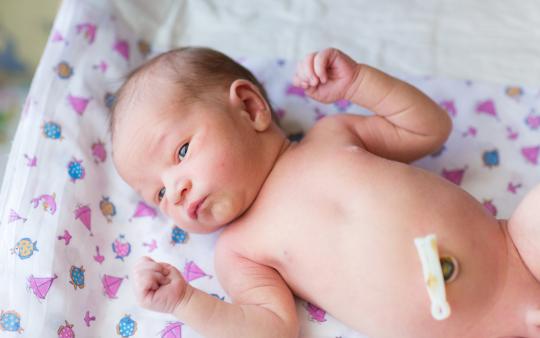Taking care of a newborn means more than changing diapers and round-the-clock feedings. Parents and caregivers must also tend to the umbilical cord stump. Like any other tissue that is healing, the skin surrounding your baby’s belly button will dry and then eventually fall off within one to two weeks. To avoid infection while it heals, it is important to keep the umbilical cord stump clean and dry.
Cleaning the umbilical area
The human body is a miracle. Left alone to heal naturally, it will do what it needs to do. This is particularly true in the case of belly buttons. The less you fuss, the faster the healing. Health care professionals used to advise rubbing alcohol swabs on healing umbilical stumps. Now research suggests that doing so may cause recovery time to take longer.
If the area around the stump becomes dirty or sweaty, it is recommended that you use a mild soap and gently clean the belly button area with a cotton swab. Sponge baths are a good idea as scrubbing and submersion is not recommended until the stump falls off.
Once the stump and surrounding skin has been cleaned, use a soft absorbent cloth and gently pat baby dry. Alternatively, fan baby with a handheld fan or piece of paper. Hair dryers are not recommended – it is far too easy to accidentally burn their delicate skin.
Support the healing process by exposing baby’s belly to the air whenever possible. When diapering, remember to fold down the front of the diaper to expose the umbilical stump. Air flow helps dry out the skin, leading to a faster recovery time.
Resist the urge to pick at the scab – allow it to dry on its own and fall off. You may notice a bit of blood around the base of the stump. This is entirely normal! There also may be some blood visible on baby’s diapers. Remember, it’s all a part of the healing process.
Signs of infection
Call your health care provider if:
- The skin around the stump is red and swollen
- The umbilical stump is oozing pus
- Baby has a fever
- Baby cries when you touch the umbilical area
Care after umbilical healing
The belly button will continue to change as the abdomen heals, but there is less reason for concern now. Occasionally, when the baby cries, the umbilicus can show signs of bulging out. This is called an umbilical hernia and will need to be looked at by a doctor. Most hernias correct themselves over time, though some cases require surgery. Another sign to watch out for is a patch of skin that appears red and moist at the base of the naval. This is called a granuloma and should also be followed up on by your doctor to ensure proper healing.









